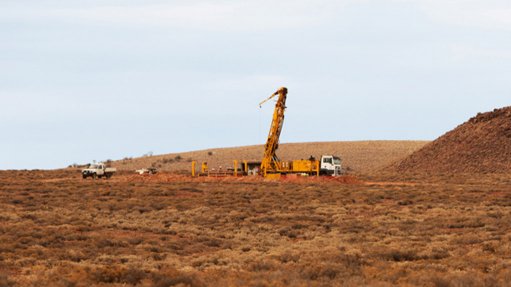
Name: Carrapateena mine.
Location: The Carrapateena deposit is located in the Gawler Craton, in South Australia, about 250 km south-east of OZ Minerals’ copper/gold operation at Prominent Hill.
Controlling Company: OZ Minerals.
Brief History: The Carrapateena deposit was discovered in 2005 by Rudy Gomez, of RMG, under the South Australian Government’s PACE exploration incentive programme. Teck acquired a 34% interest later the same year, becoming the manager of the project.
OZ Minerals bought the Carrapateena copper/gold project in May 2011. In April 2013, additional tenements were acquired from Straits Resources, bringing the total land holding to 3 624 km2.
Brief Description: The proposed Carrapateena mine project comprises four exploration licences, covering an estimated 1 070 km2, in central South Australia on the eastern margin of the Gawler Craton.
Geology/Mineralisation: Carrapateena is a copper/gold deposit hosted in a brecciated granite complex, with bornite and chalcopyrite copper mineralisation present. The bornite is a distinct higher-grade zone and contributes about 25% to the final metal produced. The deposit is located about 470 m below the surface.
The vast majority of copper and gold mineralisation within the deposit is hosted by hematite-dominated breccias with moderate mineralisation occurring within hematite altered granite breccias (Eastern copper domain). Sulphides are the primary copper-bearing minerals in the Carrapateena breccia complex. Copper and gold mineralisation is structurally and chemically controlled, with subsequent alteration destroying mineralising structures. The most abundant sulphides are chalcopyrite, pyrite and bornite, and constitute the vast majority of the sulphides at Carrapateena. The less common sulphides and their relative abundances are chalcocite, digenite, covellite, sphalerite and galena.
Gold mineralisation at Carrapateena is almost exclusively hosted by hematite-altered breccias. Gold grains are usually very small (10 µm), and when seen in polished section, are often intimately associated with copper sulphides. Gold grains are commonly a combination of gold and minor silver (electrum).
Reserves: Total probable reserves at Carrapateena as at August 15, 2014, totalled 270-million tonnes grading 0.9% copper, 0.4 g/t of gold and 4.5 g/t of silver.
Products: Copper/gold concentrates.
Mining Method: Block caving. The orebody will be mined in two lifts of about 500 m each, with primary crushing underground and ore delivery to the plant by conveyor.
Major Infrastructure and Equipment:
• A conveyor system for haulage of 12.4-million tonnes a year of production ore and additional development ore and waste from 1 500 m deep;
• two jaw-gyratory crushers for each lift with a combined capacity of 20-million tonnes a year per lift;
• a ventilation system capable of delivering 1 200 m3/s of air to the mine during the peak demand period when Lift 1 is in production and Lift 2 is under development;
• a refrigeration plant, located on surface and capable of delivering 23 MW of cooling power to fresh air being drawn into the mine;
• mine dewatering of Lifts 1 and 2 sized to cater for steady-state inflows and transient inflows of up to 70 ℓ/s; and
• underground mine services including electrical power distribution, communications, water reticulation, fire services, compressed air, fuel distribution and concrete.
Prospects: A prefeasibility study completed on the Carrapateena project has recommended that the project advance to the next stage of development, which will involve the execution of a feasibility study and the development of an exploration decline.
Contact Person: Prominent Hill operations GM Brian Kilgariff.
Contact Details:
OZ Minerals,
tel +61 8 8229 6600,
email brian.kilgariff@ozminerals.com, and
website http://www.ozminerals.com.